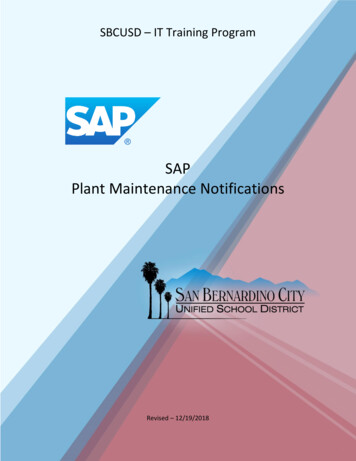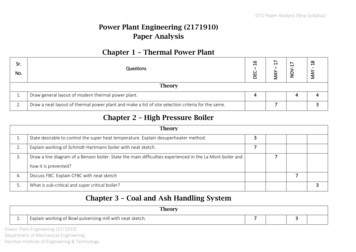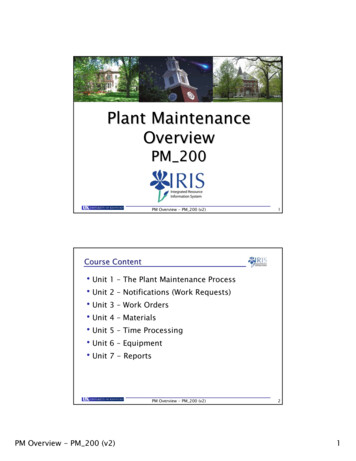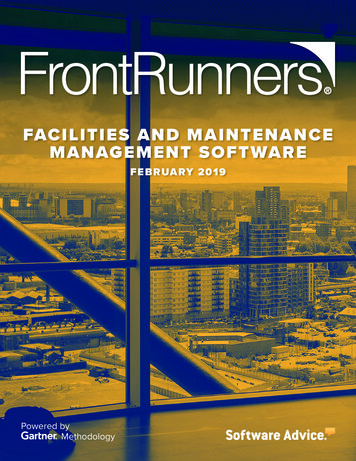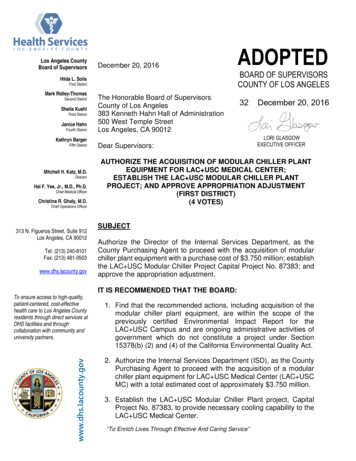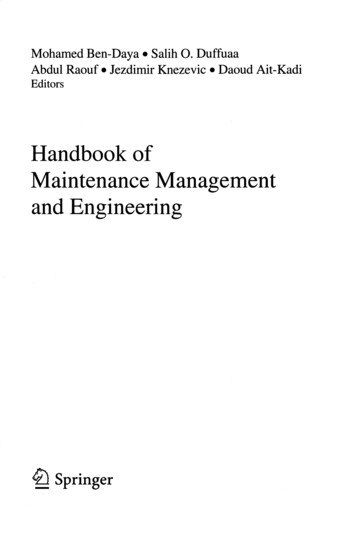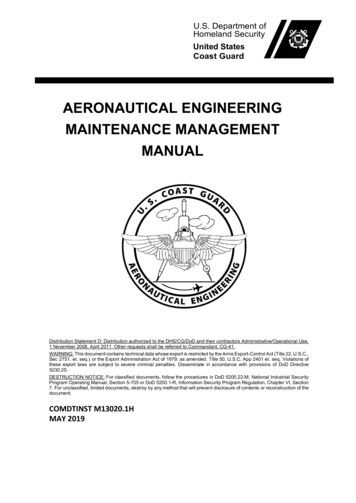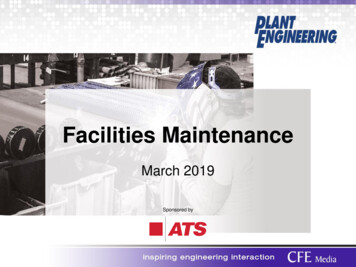
Transcription
Facilities MaintenanceMarch 2019Sponsored by
Table of contentsSectionPagesIntroduction and methodology3Summary of findings4Respondent profile5-9Facility maintenance10-24Additional resources252
Introduction and methodologyObjectiveThis study was completed by Plant Engineering to evaluate the maintenance practices and strategiescurrently in place in manufacturing facilities and the effects of maintenance on productivity andprofitability.SampleThe sample was selected from recipients of Plant Engineering for whom email addresses wereavailable. Only respondents responsible for maintenance for all or part of their facilities were askedabout maintenance strategies, outsourcing maintenance, training, technologies, and unscheduleddowntime.MethodSubscribers were sent an email asking them to participate in this study. The email included a URL linkedto the questionnaire. Data collected: Dec. 21, 2018, through Jan. 9, 2019 Number of respondents: 199o Margin of error: /- 6.9% at a 95% confidence level Incentive: Survey participants were offered the opportunity to enter a drawing for a chance toreceive a 100 Amazon.com gift card.3
Summary of findings Maintenance strategies: Seventy-eight percent of manufacturing facilities follow a preventivemaintenance strategy; 61% have a computerized maintenance management system (CMMS), and56% use a run-to-failure method. Scheduled maintenance: Fifty-three percent of facilities allocate up to 10% of their annual operatingcosts to maintenance processes; 30% devote more than 10% of this budget on maintenance. Theaverage facility spends 20 hours each week on scheduled maintenance. Attention to systems: Rotating equipment (motors, power transmission, etc.), fluid power systems(air, hydraulic, etc.), and plant automation systems are the three areas where facilities dedicate themost maintenance support, followed by internal electrical distribution systems and material handlingequipment. Unscheduled downtime: The leading cause of unscheduled downtime within respondents’ facilitiesremains aging equipment (40%), followed by mechanical failure (24%) and operator error (12%). Fourin 10 facilities plan to upgrade their equipment and improve/increase training. Training: Maintenance teams are mostly trained on basic mechanical (73%) and electrical skills(72%), as well as safety (72%). Other types of training include lubrication (55%) and motors,gearboxes, and bearings (52%). Technologies: The most common technologies facilities use to monitor/manage maintenance areCMMS (58%), in-house spreadsheets/schedules (45%), and paper records of maintenance rounds(39%). Outsourcing: The average facility outsources 19% of their maintenance operations, and the leadingcauses are lack of skills among current staff and too many specialized skills being required.4
Respondent profile5
Job titleSeventy-seven percent of respondents have engineering, maintenance, and/or supervisoryresponsibilities at their facilities.Purchasing, purchasingmanagement, ,and/or supervisory77%Q: Which of the following best describes your job title? (n 199)6
Industry experience, facility sizeRespondents have worked in a plant or engineer-related position for an average of 23 years, with 34%having been in the industry for 30 years or longer. The average facility employs 360 people.Industry experienceFacility sizeNo. of employeesLess than 5 years8%5 to 9 years10%1,000 ormore16%10 to 19 years22%Average23 years20 to 29 years26%1 to 1915%500 to 9999%20 to 4914%250 to 49912%30 to 39 years25%Average360 employees50 to 9915%100 to 24919%40 years or longer9%Q: For approximately how long have your worked in a plant or engineering-related position? (n 180); Q: How many people work at your location? (n 199)7
LocationTwenty-seven percent of respondents are located in the North Central region of the United States, andanother 18% are based outside of the U.S. Other countries represented include Canada, India, Mexico,the United Kingdom, and Venezuela.East NorthCentral18%Pacific7%Mountain4%West NorthCentral9%West thCentral4%SouthAtlantic15%*Data gathered by matching respondents to their Plant Engineering audience profile.8
Primary businessThe top primary businesses represented by respondents are food, beverage, and tobacco (13%),government or military (7%), and plastics and rubber manufacturing (7%).Food, beverage, tobacco13%Machinery3%3%Government or military7%Mining and mineral productsPlastics and rubber7%Agriculture or construction2%Automotive and othertransportation equipment2%Distribution centers, warehousing2%Electrical equipment,appliance, and components2%Pharmaceuticals2%Primary metals2%Chemicals6%Utilities (incl. electric,gas, water, waste)6%Aircraft, aerospace, or defense5%Hospitals, health care facilities5%Plant/facilities engineeringor maintenance services5%Miscellaneous4%Fabricated metals3%Textiles, apparel,and leather productsComputers, communications,consumer electronicsSystem integration, consulting,business, or technical servicesInstrumentation, controlsystems, test, measurement3%OtherOil, gas, and petroleum(incl. refining)Wood, paper, and relatedprinting activities4%4%2%1%1%6%Q: What is the primary business at your location? (n 180)9
Facility maintenance10
Scheduled maintenanceThe average facility allocates approximately 9.2% of its annual operating budget to maintenanceprocesses. One-third of facilities spend 30 hours or more each week on schedule maintenance; averageis 20 hours/week.Maintenance budgetScheduled maintenance% of operating budgetWeeklyDon't know17%Less than5%22%30 hoursor more33%Less than5 hours11%5 to 9hours22%More than15%16%11% to15%14%5% to 10%31%Average20 hoursAverage9.2%20 to 29hours13%10 to 19hours21%Q: What percentage of your plant's annual operating budget is spent on maintenance processes? (n 199);Q: Approximately how many hours per week does your plant spend on scheduled maintenance? (n 199)11
Scheduled maintenance shutdown frequencyThirty-one percent of facilities shutdown standard machinery used in production every month forscheduled maintenance; 25% shutdown their materials handling equipment two to four times each yearfor regular maintenance.YearlyTwice a yearQuarterly0%Conveyor and productionline systems (automated)Standard machinery usedin production (automated)Every other month10%13%20%30%7%15%7%Monthly40%Twice a %10%Materials handling equipment12%11%14%28%16%Packaging systems12%9%17%25%13%12%21%7%Specialized productionmachinery (automated)Less automated (manual) systems10%17%9%17%13%26%10%26%14%100%10%8%Q: How often are the following areas of your plant shutdown for scheduled maintenance? (n 130;175;165;127;169;184)12
Attention to systems maintenanceRotating equipment (motors, power transmission, etc.), fluid power systems (air, hydraulic, etc.), andplant automation systems receive the most maintenance support.A great deal0%Fluid power systems(air, hydraulic, etc.)10%A lotSome (little)20%12%30%9%28%Material handling equipment8%29%Rotating equipment(motors, power transmission, etc.)50%60%32%Internal electricaldistribution systemsPlant automation systems40%None at all (or %42%6%Q: How much maintenance support do the following areas of your facility receive? (n 199)13
Unscheduled downtimeAging equipment (40%) and mechanical failure (24%) are the leading causes of unscheduled downtime.In an effort to decrease downtime, 43% of facilities plan to upgrade equipment, 38% aim toimprove/increase frequency of training, and 33% will introduce a preventive maintenance strategy.Leading causeLack ofmaintenance3%Lack ofpropertraining5%Lack of timeto performmaintenance8%Plans to decrease downtimeUpgrade equipmentDon't know1%Improve training,increase frequencyOther7%33%Expand monitoringcapabilities31%Change maintenancestrategy30%Increase scheduleddowntimeMechanicalfailure24%38%Introduce preventivemaintenance lement automatedanalytics/machine learningOther10%3%Q: What is the leading cause of unscheduled downtime in your plant? (n 199); Q: How do you plan to decrease unscheduled downtime in your plant? Check all that apply. (n 199)14
Maintenance personnel trainingMore than half of facilities’ maintenance personnel receives training in basic mechanical skills (73%);basic electrical skills (72%); safety (72%); lubrication (55%); motors, gearboxes, and bearings (52%);and predictive maintenance (51%).Basic mechanical skills73%Basic electrical skills72%Safety72%Lubrication55%Motors, gearboxes, bearings52%Predictive maintenance51%Basic plumbing/pipefitting46%Calibration41%Computers, data logging, etc.38%Equipment/system programming35%Process operations33%Welding and fabricating33%Blueprint reading32%Fluid power systems32%Machine stop technology28%Other4%None5%Q: What kind of training does your maintenance personnel receive? Check all that apply. (n 199)15
Maintenance technologiesFewer facilities are using in-house created spreadsheets and schedules to monitor or managemaintenance than last year (45% versus 55% in the 2018 report).Computerized maintenancemanagement system (CMMS)58%In-house created spreadsheetsand schedules (e.g., Microsoft Excel)45%Clipboards and paper recordsof maintenance rounds39%Automated maintenance schedule generatedby manufacturing scheduling system34%General computerized calendar(e.g., Microsoft Outlook)Enterprise asset management (EAM)Industrial Internet of Things (IIoT)Other23%11%7%3%Q: What technologies are used to monitor or manage maintenance within your plant? Check all that apply. (n 198)16
Percentage of operations that is part of maintenanceLooking at the relationship between operations teams and maintenance departments, an average of21% of a facility’s operations personnel are also responsible for maintenance duties.30%% of responses25%20%15%Average21%10%5%0%% maintenanceQ: What percentage of your plant's operations team is part of your maintenance department? (n 199)17
Outsourcing maintenanceThe average facility outsources 19.2% of their maintenance operations. The top reasons for outsourcing,according to 2019 data, are lack of skills among current staff (52%), too many specialized skills required(41%), and a desire to lower overall costs (40%).Percentage outsourcedReasons for outsourcing0%More than40%13%Don't know5%20%40%60%Lack of skills amongcurrent staff0%12%31% to40%3%Too many specialized skillsrequired to be practicalDesire to lower overall costs21% to30%15%Average19.2%1% to 10%31%11% to20%21%Lack of time, manpower todedicate to maintenanceLack of necessaryequipment available2017Insufficient budget to hire/retain skilled individuals20192018Skilled individuals simplynot availableUnion considerationsQ: How much of your plant's maintenance operation is outsourced? (n 199); Q: Which factors led to the outsourcing of maintenance operation at your plant? Check all that apply. (n 268;167;165)18
Attitude towards maintenanceFifty-nine percent of engineers and managers see maintenance as a cost center, most of whomunderstand the need to spend in order to keep equipment running. Another 34% see maintenance as aprofit center that delivers greater capacity to their facility.It’s a cost center, andwe need to carefullycontrol costs.15%It’s a necessary evil.7%It’s a profit centerwhere we can delivergreater capacity to ourplant.34%It’s a cost center, butwe need to spend inorder to keepequipment running.44%Q: Which of the following statements best describes your attitude toward maintenance? (n 199)19
Challenges to improving maintenanceKey challenges to improving facility maintenance include lack of resources or staff (48%), lack ofunderstanding about new maintenance options and technologies (38), and lack of training (32%).Lack of resources or staff48%Lack of understanding of newmaintenance options/technologies38%Lack of training32%Employee buy-in29%Lack of available funding29%Outdated technology28%Lack of support from management26%Poor scheduling,rarely followed through17%Safety issuesSecurity issuesOther9%2%4%Q: What are the key challenges for improving maintenance at your facility? Check all that apply. (n 199)20
Plant usage of handheld/mobile devicesFifteen percent of facilities allow the use of handheld or mobile devices for communications betweenmaintenance personnel and schedules; 8% allow these devices to schedule maintenance and provideinformation about machine health and work history.Devices are fullyintegrated into a plantwide CMMS or IIoTsystem6%Use for scheduling, toprovide informationabout the machine andits work history at therepair site8%Don'tknow6%Do not use but arestudying/may considerfuture use39%Use forcommunicationsbetween maintenancepersonnel andschedulers15%Do not use,no plans to use26%Q: To what extent is your plant using handheld/mobile devices for plant maintenance? (n 198)21
Impact of the Industrial Internet of ThingsTwenty-eight percent of engineers and managers believe that adopting the Industrial Internet of Things(IIoT) will help them to better understand machine health, and therefore keeping up with planned routinemaintenance. Another 28% are unsure of how or if IIoT would impact their facility’s maintenanceoperations.Will help to better understand machine health28%Will help to better predict andprevent plant shutdowns27%Will change how plant maintenance personnelwork and interact with all levels of operationWill have no impact25%22%Don't know28%Q: How will the Industrial Internet of Things (IIoT) impact plant maintenance operations? Check all that apply. (n 199)22
Maintenance strategiesFacilities are using multiple maintenance strategies, depending on the equipment on the plant floor.Seventy-eight percent use a preventive maintenance strategy, while 61% employ a CMMS, and 56% optto use a reactive maintenance approach.78%80%78%Preventive maintenance information59%Computerized maintenancemanagement system (CMMS)50%61%61%57%56%Reactive maintenance (run-to-failure)47%51%43%Predictive maintenance (PdM)using analytical tools20172018201928%33%24%Reliability-centered maintenance (RCM)using operational data analysis5%Other1%2%Q: Which of the following maintenance strategies are present within your plant? Check all that apply. (n 322;201;199)23
Maintenance strategies: advantagesThe top advantage to a predictive maintenance strategy is a low initial cost, followed by ease of use,while a preventive maintenance strategy also boasts low initial cost, ease of use, and other keybenefits—such as decreased downtime, cost effective overall, and improved MS100%0%Better productivityImproved safetyCost effective overallIncreased componentsafetyDecreases downtimeLow initial costEase of useMinimize overhaulfrequencyEnergy savingsOverall efficiencyFewer maintenancestaff involvedOverall equipmenteffectivenessFlexibilityReduced probabilityof failureRCM20%40%60%80%100%Q: What are the advantages to the maintenance strategy/strategies in place at your plant? Check all that apply in each column. (n 155;122;111;86;48)24
Additional resources from Plant EngineeringThank you for downloading the Plant Engineering 2019 Maintenance Study. Use the links below toaccess additional information on manufacturing facility maintenance strategies.Maintenance news and articles Asset management Lean maintenance Contract maintenance Inventory Material handling Maintenance strategyOther resources New Products for Engineers Online training: CFE Edu Webcasts Case studies Ebooks Maintenance Connection newsletter Predictive & Preventive MaintenancenewsletterEditorial research studies 2018 Salary Survey 2018 Predictive Maintenance 2018 Facilities Maintenance Additional studies available at:www.plantengineering.com/researchContact informationAmanda PelliccioneDirector of Researchapelliccione@cfemedia.comBob VavraContent Managerbvavra@cfemedia.com25
Engineering, maintenance, and/or supervisory 77% General management 22% Purchasing, purchasing management, other 1%. Industry experience, facility size 7 Respondents have worked in a plant or engineer-related position for an average of 23 years, with 34% having been in the industry for 30

